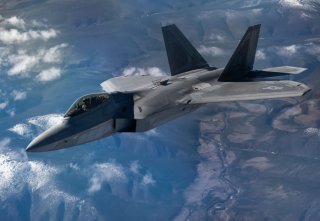Enemy Hackers Could Be the Threat the F-35 Never Sees Coming
They call the F-35 a “flying computer” for a reason.
Here's What You Need to Remember The increasingly serious cyber threat to major platforms and weapons systems is by no means restricted to the F-35. For instance, successful hacking or cyber intrusions could disrupt vital targeting and guidance systems needed for precision weapons, derail computer-enabled aircraft navigation and targeting, or even seek to change the flight path of a drone or ICBM. CROWS is also designed to harvest the best thinking when it comes to anticipating potential enemy cyberattacks.
They call the F-35 a “flying computer” armed with artificial intelligence-like sensor fusion, 360-degree cameras, advanced data links, an extensive database of threat information and a complex computerized logistics systems. So what happens if the stealth fighter jet is hacked? Its threat data could be compromised, weapons guidance derailed or, perhaps worst of all, its entire flight path or data sharing systems could be destroyed.
The greater the advantage afforded by advanced computing and a new-generation of processing speed and AI-enabled algorithms, the greater the need to “harden” the system and ensure it is sufficiently resilient. This reality is not lost, for example, upon Lockheed developers or Air Force cyber specialists who have in recent years been immersed in an accelerated effort to secure weapons systems and major platforms against cyber attackers.
The Air Force has, for several years now, been taking new strides with an ambitious, yet crucial effort known as Cyber Resilience Office for Weapons Systems, or CROWS. The concept for the office, established by Air Force Materiel Command several years ago, is grounded upon the premise that countermeasures and cyber protections, such as emerging technologies such as Boot Shield or Countervail, need to be “baked in” early and “layered” into prototypes for weapons systems early in the developmental process.
Along with the well-known “sensor fusion” able to organize and display crucial targeting, surveillance, avionics and navigational data on a single screen for pilots, there are a range of systems on the F-35 which rely heavily upon advanced computing. Other systems on the F-35 engineered for greater levels of automation include the Autonomic Logistics Information System, or ALIS—a logistics and sustainment computer which, among other things, assesses health and maintenance of avionics, engine systems and other aircraft functions. The idea is to replace the necessity of manual checks by engineering computers able to perform more systematic functions on their own.
Computer technology increasingly organizes, integrates and presents information for pilots with an improved efficiency and graphical user interface. Developers often refer to this as “easing” the cognitive burden so that the dynamic human mind can better direct its energy toward tasks it is uniquely able to perform, such as problem-solving.
The F-35’s Distributed Aperture System, a suite of sensors around the aircraft that provides pilots a 360-degree view of the battlespace, is another example of advanced computer integration. The aircraft’s Electro-Optical Targeting System, or EOTs, is in the same category. The F-35s Mission Data Files as well, a compilation or data library of known threats specific to designated threat areas across the globe, represents the kind of system which simply cannot be hacked. Should an intruder destroy, derail or infect the database with wrong information, attacking F-35 pilots could face complete mission failure. Therefore, the threat information, which continues to grow more elaborate and extensive to incorporate emerging threats, needs to be both accessible for sensors and fire control systems needed by pilots yet also completely hardened against external attack.
This phenomenon, wherein cybersecurity threats continue to rapidly expand well beyond IT and data systems to reach larger platforms and weapons systems, is often discussed in terms of a two-fold trajectory. While advanced computer processing, sophisticated algorithms and better networked weapons and fire control bring unprecedented combat advantages, increased cyber-reliance can also increase risk in some key respects.
The increasingly serious cyber threat to major platforms and weapons systems is by no means restricted to the F-35. For instance, successful hacking or cyber intrusions could disrupt vital targeting and guidance systems needed for precision weapons, derail computer enabled aircraft navigation and targeting, or even seek to change the flight path of a drone or ICBM. CROWS is also designed to harvest the best thinking when it comes to anticipating potential enemy cyberattacks.
Kris Osborn is the defense editor for the National Interest. Osborn previously served at the Pentagon as a Highly Qualified Expert with the Office of the Assistant Secretary of the Army—Acquisition, Logistics & Technology. Osborn has also worked as an anchor and on-air military specialist at national TV networks. He has appeared as a guest military expert on Fox News, MSNBC, The Military Channel, and The History Channel. He also has a Masters Degree in Comparative Literature from Columbia University. This article first appeared earlier this year.
Image: Flickr.

